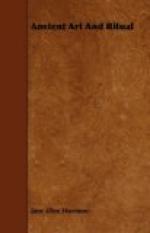Take the representations of Osiris that we have just described—the mummy rising bit by bit from his bier. Can any one maintain that art is here a copy or imitation of reality? However “realistic” the painting, it represents a thing imagined not actual. There never was any such person as Osiris, and if there had been, he would certainly never, once mummified, have risen from his tomb. There is no question of fact, and the copy of fact, in the matter. Moreover, had there been, why should anyone desire to make a copy of natural fact? The whole “imitation” theory, to which, and to the element of truth it contains, we shall later have occasion to return, errs, in fact, through supplying no adequate motive for a widespread human energy. It is probably this lack of motive that has led other theorizers to adopt the view that art is idealization. Man with pardonable optimism desires, it is thought, to improve on Nature.
* * * * *
Modern science, confronted with a problem like that of the rise of art, no longer casts about to conjecture how art might have arisen, she examines how it actually did arise. Abundant material has now been collected from among savage peoples of an art so primitive that we hesitate to call it art at all, and it is in these inchoate efforts that we are able to track the secret motive springs that move the artist now as then.
Among the Huichol Indians,[4] if the people fear a drought from the extreme heat of the sun, they take a clay disk, and on one side of it they paint the “face” of Father Sun, a circular space surrounded by rays of red and blue and yellow which are called his “arrows,” for the Huichol sun, like Phoebus Apollo, has arrows for rays. On the reverse side they will paint the progress of the sun through the four quarters of the sky. The journey is symbolized by a large cross-like figure with a central circle for midday. Round the edge are beehive-shaped mounds; these represent the hills of earth. The red and yellow dots that surround the hills are cornfields. The crosses on the hills are signs of wealth and money. On some of the disks birds and scorpions are painted, and on one are curving lines which mean rain. These disks are deposited on the altar of the god-house and left, and then all is well. The intention might be to us obscure, but a Huichol Indian would read it thus: “Father Sun with his broad shield (or ‘face’) and his arrows rises in the east, bringing money and wealth to the Huichols. His heat and the light from his rays make the corn to grow, but he is asked not to interfere with the clouds that are gathering on the hills.”




